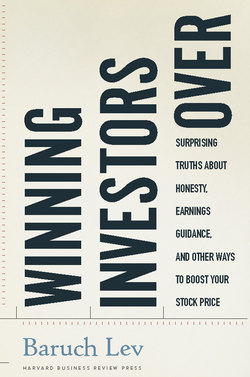Читать книгу Winning Investors Over - Baruch Lev - Страница 9
На сайте Литреса книга снята с продажи.
The Not-So-Bell-Shaped Earnings Surprises
ОглавлениеMany wonder why investors take so seriously an earnings consensus miss, even by a penny. Simply, because relatively few companies get entrapped in this predicament. Look at figure 1-1 from Mei Feng’s 2008 study of quarterly EPS surprises, which displays the difference between reported EPS and the last consensus estimate available prior to earnings release. Feng’s sample is very large and representative: 180,000 quarterly observations from 1988 through 2005, an average of 2,500 companies per quarter. The highest bar, situated in the center of the graph, indicates that roughly 24,000 observations (about 13 percent of the sample) were perfect hits, where reported EPS matched the consensus to the penny. Many companies fared even better: the three successively decreasing bars to the right of zero surprise indicate that about 47,000 cases—over a quarter of the sample—beat the consensus by $.01 to $.03. Thus, a whopping 71,000 cases, almost 40 percent of the sample, meet or beat by $.01 to $.03 the analysts’ forecasts. This, mind you, is the optimal play of the earnings game. You want to beat the consensus, but not handily, lest analysts raise the bar substantially for next quarter or year.
FIGURE 1-1
Earning surprises: Reported EPS minus analyst consensus estimate, 1988–2005
Source: Mei Feng, “Why do managers meet or slightly beat earnings forecasts in equilibrium? An endogenous mean-variance explanation,” working paper, Katz Graduate School of Business, University of Pittsburgh, 2008.
In sharp and painful contrast, the three bars to the left of the perfect hit indicate that only about 27,000 cases (15 percent of the sample) miss the consensus by $.01 to $.03. Herein lies the main answer to the opening question: missing the EPS consensus estimate even by a few pennies takes a heavy toll on the stock because it places you in the minority of underperformers. Not good company to keep. Moreover, given that the majority of companies manage to avoid missing the consensus, those who get entrapped are presumed not only to come short of expectations, but also to have tried every means available, legit or not, to get over the consensus hump and failed. This obviously suggests to investors the existence of serious business issues lurking in the background, causing the strong negative reaction to even a one-penny miss.3
There is another remarkable feature in figure 1-1. In such a large sample of EPS surprises, encompassing eighteen years of boom and bust and including thousands of companies operating in most economic sectors, it is reasonable to expect the earnings surprises to be bell-shaped—symmetrically distributed around zero: a certain number of consensus matches at the center, flanked on both sides by a roughly equal and decreasing number of negative and positive surprises. But look closely at the figure and you will see a surprising—no pun intended—pattern of earnings surprises. Centered on top of zero surprise is, as expected, the highest bar, but to its right are the two next-highest columns, indicating that beating analyst forecasts by $.01 to $.02—a dream come true—is the second most-frequent occurrence. Missing the consensus by a penny is only the fourth-highest bar in the graph. In fact, the ratio of $.02 consensus hits to misses is 1.7:1—hardly a bell-shaped phenomenon.
Clearly, something other than chance is going on here. If the outcomes of repeated rolls of a dice would resemble the figure, the inescapable conclusion would be that the dice are loaded. So what’s going on with the earnings game between managers and analysts? Are analysts chronically pessimistic, systematically underestimating earnings, thereby creating an overwhelming number of consensus beats? Highly unlikely, since analysts and their employers profit primarily from people buying stocks, and downcast earnings forecasts are hardly a recipe for investment. Moreover, pessimistic forecasts—driving away investors—will bring down on analysts the wrath of managers, likely severing the all-important managers–analyst information channel.4 In fact, my evidence indicates that analysts are, if anything, optimistic. More likely, the unexpectedly large number of consensus beaters is caused by suave “earnings gamers” who either succeed in guiding—“walking down”—analysts to lower the forecast bar sufficiently for them to surpass it, and/or those who “manage” (simply put, manipulate) reported earnings to meet or slightly beat the forecast. The former manage the consensus, whereas the latter manage earnings. And then there are those who manage both. The 1.7:1 asymmetry between consensus beaters and missers strongly suggests that earnings gamers are far from an endangered species.5
The widespread earnings game poses a serious ethical and practical dilemma for honest managers. What to do when competitor managers are manipulating earnings and, in the process, are securing investors’ favor and low-cost funds? Persist with a depressed stock—an invitation to activist shareholders and takeover specialists—or join the manipulators? A vivid example of this dilemma involved a superstar of the early 2000s scandals, WorldCom, and its fierce competitors AT&T and Sprint. In the late 1990s and early 2000s, WorldCom engaged in one of the most brazen accounting scams in history, inflating reported earnings by more than $10 billion through the capitalization (recorded as assets) of regular operating expenses. The fraudulently “superior” performance of WorldCom—fast-growing earnings and enviable margins—totally spooked financial analysts and placed heavy pressure on AT&T and Sprint managers to shape up and match the “performance” of their star competitor, which, to their credit, they refrained from doing. The twenty-five-year prison term given in 2005 to Bernie Ebbers, WorldCom’s CEO at the time of the fraud, was probably a small consolation to AT&T’s and Sprint’s beleaguered executives, and to their shareholders living dangerously for several years with depressed share prices. Research on “scandal companies” depressingly indicates that executives of competing firms saw their compensation drop as the manipulators “outperformed” them.6 I will return to the intriguing issue of earnings manipulation in this chapter and in chapter 4, but first let’s examine briefly the partners to the earnings game: financial analysts.
